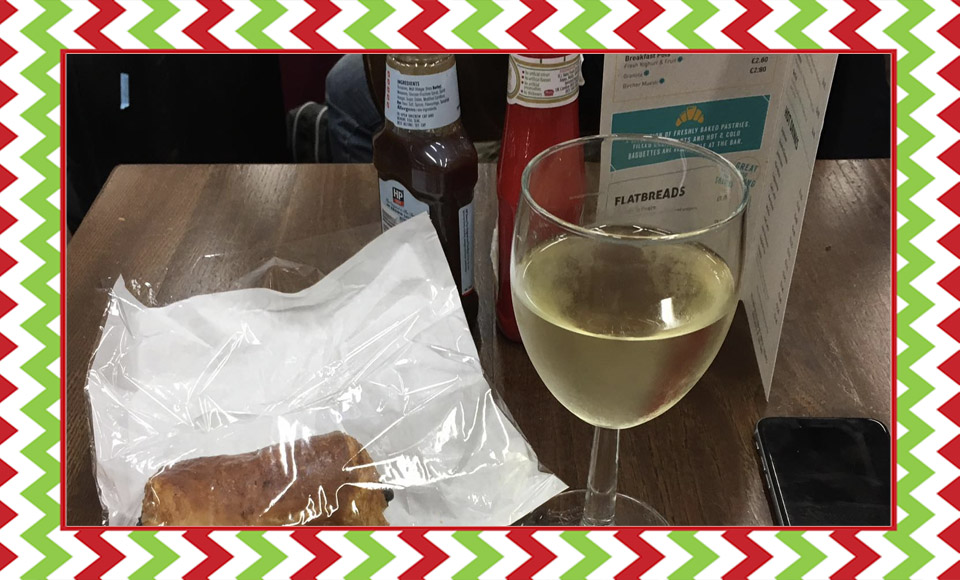Day 5 - Shambles Advent
Blog in a Teacup by Dr Helen CzerskiDay 5 – @iamaharris
Every day until Christmas Dr Helen Czerski will be finding some cool, hidden science in pics of people’s every day lives. To get involved, tweet your pic to @helenczerski and @cosmicshambles with the hashtag #ShamblesAdvent

This photo was taken by David Harris (@iamaharris) in St Pancras station. The detail that caught my eye was the brown sandwich crust. It’s something that we absolutely take for granted – the outside of baked bread often goes dark brown, but the crust is very thin and the rest of the bread (which was all obviously also in the oven at the same temperature) is much paler.
I think that the interesting bit here is the difference between the bits that go brown and the bits that don’t. The browning itself comes from a set of chemical reactions that we should be very grateful for, and which all fit under the umbrella of the “Maillard reaction”. The basic pattern is that at high temperature, proteins and sugar react together to form a cascade of new ingredients, which are particularly tasty and come in various shades of brown. Versions of this reaction are responsible for the yumminess of toast, toasted marshmallows and fried food. You can speed it up in a few ways, but the most important control is the temperature. The hotter it gets, the more brown yumminess, right up to the point where it all goes a bit too far and things start turning into charcoal.
Depending on the bread, the oven temperature is likely to be between 180C and 250C. But the baking bread itself isn’t anywhere near that. Bread dough contains lots of water, and as it’s heated, that water starts to evaporate – to escape from being a liquid into the gas phase. This process sucks up a huge amount of energy, and so all the heat energy going into the bread is used up for evaporation. The bread just can’t get above 100C until all the water has evaporated. But the time in the oven isn’t long enough to do that (otherwise bread would just be dry foam). So the temperature on the inside is limited, and the Maillard reaction is held in check, possibly providing a hint of a tan on the inside of the cooked loaf, but nothing more.
But the outermost layer of the bread dries out very quickly, and once the water is gone, the temperature whooshes upwards. The Maillard reaction chugs along with enthusiasm, producing a crisp brown crust, full of all those lovely flavour molecules. So David’s half-eaten sandwich here is a reminder of why a crust is so thin, and the weird fact that even in a super-hot oven, the inside of bread never goes above the boiling point of water.
This is also scientific justification for always eating your crusts. They are absolutely the best bit!
Read the rest of Helen’s advent posts here
The Cosmic Shambles Network relies on your support on pledges via Patreon so we can continue to provide great, new, exciting content without the need for third party ads or paywalls.
For as little as $1 a month you can support what we do and get some great rewards for doing so as well. Click the Patreon logo to pledge or find out more.
 Dr Helen Czerski is a physicist, first and foremost, but she’s acquired a few other labels along the way: oceanographer, presenter, author and bubble enthusiast. A regular on The Cosmic Shambles Network, she has also presented a number of acclaimed documentaries for the BBC and her first book, Storm in a Teacup, which looked at the physics of every day things, was a bestseller. Recently she was awarded the prestigious William Thomson, Lord Kelvin Medal and Prize from the Institute of Physics.
Dr Helen Czerski is a physicist, first and foremost, but she’s acquired a few other labels along the way: oceanographer, presenter, author and bubble enthusiast. A regular on The Cosmic Shambles Network, she has also presented a number of acclaimed documentaries for the BBC and her first book, Storm in a Teacup, which looked at the physics of every day things, was a bestseller. Recently she was awarded the prestigious William Thomson, Lord Kelvin Medal and Prize from the Institute of Physics.
If you would like to reuse this content please contact us for details
Subscribe to The Cosmic Shambles Network Mailing list here.


